Destruction of the Heilsberg Group (4 Army)
After Vasilevsky completely led the operation to defeat the enemy in East Prussia, he decided to temporarily suspend the offensive on the Zemland Peninsula and focus his efforts on the destruction of the most powerful Heilsberg group. According to the German group, it was decided to deliver two simultaneous attacks from the east and southeast in the general direction to Heiligenbäuil in order to dismember and destroy the enemy group of forces in parts. Then they planned to regroup and defeat the German forces in Königsberg and on the Zemland Peninsula. Aviation two air armies was supposed to support the advance of the ground forces. The Soviet Headquarters approved this plan.
Since mid-March 1945, the Baghramian Zemland Group of Forces has focused on preparations for the elimination of the Zemland and Königsberg enemy groupings. Meanwhile, the headquarters of the 3 of the Byelorussian Front concentrated efforts to destroy the Heilsberg enemy grouping. March 13 Soviet troops resumed the offensive. The Red Army achieved the greatest success in the area between Königsberg and the Frich River. Here our troops broke through to the sea, cutting off the Königsberg-Elbing highway, finally isolating the 4 German army from the capital of East Prussia.
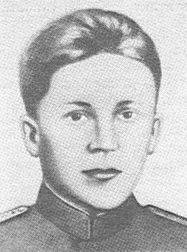 Despite the desperate resistance of the German troops, the Red Army continued to rush forward. Soviet soldiers showed the highest examples of heroism and self-sacrifice. In the battle for the Deutsch-Tirau stronghold, which covered the approaches to the city of Heiligenbeil (Heiligenbeil) - the main resistance node of the enemy, tankers of the 2nd Separate Guards tank Brigades of the 31st Army of the 3rd Belorussian Front showed their military skill and heroism. So, on March 16, a company of the 1st Tank Battalion of the Guard Lieutenant Ivan Ladushkin first organized a breakthrough of the heavily fortified enemy defenses 10 km southwest of the city of Heiligenboyle. Early in the morning, the tankers went around the enemy battery, which the battalion attacked from the front. When the Germans discovered Soviet tanks and tried to deploy guns, it was too late. The key position has been taken.
Despite the desperate resistance of the German troops, the Red Army continued to rush forward. Soviet soldiers showed the highest examples of heroism and self-sacrifice. In the battle for the Deutsch-Tirau stronghold, which covered the approaches to the city of Heiligenbeil (Heiligenbeil) - the main resistance node of the enemy, tankers of the 2nd Separate Guards tank Brigades of the 31st Army of the 3rd Belorussian Front showed their military skill and heroism. So, on March 16, a company of the 1st Tank Battalion of the Guard Lieutenant Ivan Ladushkin first organized a breakthrough of the heavily fortified enemy defenses 10 km southwest of the city of Heiligenboyle. Early in the morning, the tankers went around the enemy battery, which the battalion attacked from the front. When the Germans discovered Soviet tanks and tried to deploy guns, it was too late. The key position has been taken. Then Ladushkina’s company entered the battle for the Doych-Tirau stronghold. Here the German troops had several anti-tank batteries, assault guns, reinforced concrete and wooden-earthen long-term firing points, covered with barbed wire and minefields. Already at night Soviet tankmen broke into the settlement. The fight was fierce. The fires were fired practically to the stop, focusing on the outbreaks of enemy firing points. In these battles, the company of Ladushkina destroyed more than 70 enemy soldiers, 15 anti-tank guns, an assault gun, and captured more than 100 Germans.
In this battle, Ladushkin’s tank was hit. Ivan Ladushkin, wounded and burned, jumped out of the car and got into another, continuing the battle. After a hard night's battle, the enemy's stronghold was taken. The enemy was forced to start a retreat. Continuing the battle, the Soviet tankers continued the offensive. On the outskirts of Deuich-Tirau, Ladushkin's tank was again shot down. The hero died a brave death. By decree of the Presidium of the Supreme Soviet of the USSR from 29, June 1945, to Guard Lieutenant Ladushkin, Ivan Martynovich, posthumously awarded the title Hero of the Soviet Union. In 1946, the city of Ludwigsort (Ladushkin, Kaliningrad region) was renamed in his honor.
During the fierce fighting, our troops advanced to 19 March by 15-20 kilometers. The foothold of the enemy grouping was reduced to 30 km along the front and 7-10 km in depth. The situation for the German troops was critical. The German bridgehead was completely swept by Soviet artillery and heavy mortars. Since a huge amount of weapons, equipment and manpower, every Soviet shell, mine and bomb brought results. There was a destruction of enemy groups.
A large role in these battles was played by Soviet aviation. Bombers attacked enemy strongholds, while Po-2 night bombers continued to bomb German battle formations at night. Attack aircraft worked all day, attacking manpower and equipment of the German group.
20 March 1945 The German command was forced to decide on the evacuation of the 4 Army to the Pillau area. According to the Germans, there were still about 4 thousand soldiers and officers in the 150 Army. However, since there were no such number of free vehicles, German soldiers had to burrow into the ground and continue to fight. March 25 The German command ordered the 4 Army to continue the defense of the bridgehead, especially in the Balga peninsula. The 4 armies could no longer fulfill this order, it was falling apart.
Continuing to smash the enemy, our troops in several areas reached the sea, dividing the Heilsberg group into several separate parts. The sweep of the Gulf Coast from the isolated groups of the enemy began. In panic, the German troops stopped resistance, rushed to the bay and tried to get to the Frische-Nerung Spit. However, they met a powerful fire of Soviet artillery. Only an insignificant part of the defeated German army (about 5 thousand soldiers) were able to break into the Frische-Nerung spit in Pillau. Thus, the headquarters of the 4 Army was evacuated to Pillau. By March 26, the Germans continued to hold only a small foothold on the Balga peninsula. Three days later, the remnants of the 4 of the German army were finished off.
Thus, the troops of the 3 of the Byelorussian Front overcame the powerful lines of the Heilsberg fortified area and completely defeated the 4 of the German Army. Only from 13 to 29 March 1945, our troops destroyed more than 93 thousand and captured more than 46 thousand enemy soldiers and officers. A large number of weapons and equipment were captured, including about 5 thousand guns and mortars. Thus ended the battle to eliminate the Heilsberg enemy grouping, which lasted 48 days.
Among the reasons for the protracted battle, historians point out the following: the power of the fortifications of the Heilsberg fortified area; skillful and fierce resistance of the Wehrmacht; the possibility of supplying German troops by sea; spring thaw and adverse meteorological factors; the bloodlessness of the Soviet divisions of the former battles and the backlog of the rear, which reduced the combat capability of the Soviet troops.
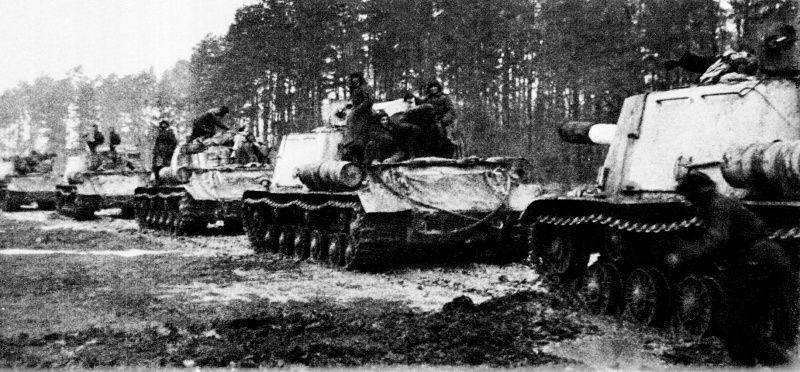
A convoy of Soviet self-propelled guns ISU-152 is marching to new combat lines for attacking Königsberg fortresses
Photo source: http://waralbum.ru/
Koenigsberg operation
After the destruction of the Heilsberg grouping of the enemy, the Supreme Command Headquarters abolished the command and control of the Zemland Group of Forces, which came under the direct control of the front command. Now Vasilevsky’s armies had to liquidate the Koenigsberg grouping, take the capital of East Prussia, and then clear the land of Zemland with the fortress and the port of Pillau.
The forces of the parties
Soviet Union. The task of eliminating the Koenigsberg group was solved by the 3 of the Byelorussian Front under the command of A. M. Vasilevsky. By the beginning of April, six armies (80 rifle corps) were concentrated on the 18-kilometer front: the 2-th Guards Army of Porfiry Chanchibadze was stationed on the north coast of the Sublands of Peninsula, then Nikolai Krylov's 5-army of the North-West were deployed to the south enemy grouping), 39-I army of Ivan Lyudnikov, 43-I army of Athanasius Beloborodov, 50-I army of Fedor Ozerov and 11-I guards army of Kuzma Galitsky. The armies of Beloborodov and Ozerov blocked the capital of East Prussia from the north and east. Guards Army Galician took up positions south of the city. Lyudnikova's army was located north-west of Königsberg and had to cut the communications of the Königsberg garrison and reach the coast of Frisher-Haff Bay. Other armies acted on the Samland Peninsula. The Soviet group, which directly stormed Königsberg, numbered thousands of people according to various data 100-130.
Map source: Galitsky KN. In the battles for East Prussia: Notes by the commander of the 11 Guards Army
Germany. In early April, before the Soviet troops defended the operational group "Zemland", which was included Koenigsberg group. The Zemland group had 4 army corps, Königsberg garrison and several separate units. Total 11 divisions, 1 brigade, separate infantry and special regiments and militia battalions. In addition, the Germans tried to urgently restore several divisions from the defeated 4 th field army. According to Soviet intelligence, the German forces in general numbered about 200-250 thousand people.
The German forces were positioned as follows: the 9 Army Corps (551, 95, and 93 Infantry Divisions) defended from the northern coast of the Zemland Peninsula to Varengen; The 26 Army Corps (1-I East Prussian and 58-I Infantry Divisions) defended the Wargengen - Varglitten sector; Königsberg garrison (548, 561, 367 and 69 infantry divisions, headquarters of 61 infantry division, Mikosh division type combat group, Schubert police combat group, 6 separate regiments and 21 combat divisions and 5 combat group, 286 individual regiments and 10 divisional type X-forces ). The XNUMX-I tank division, the XNUMX-I infantry division and the XNUMX-I scooter brigade were deployed on the Zemland Peninsula as an army reserve. These were the troops of the first echelon.
In addition, in the second echelon, the remnants of the 4 th field army were located. Army hastily restored. It consisted of the 55 Army Corps (50, 83 and 170 infantry and 13 anti-aircraft divisions). On the Frische-Nerung Spit, the remnants of the 6 Army Corps were in reserve, which was defeated at the end of March in the Heiligenbeuil area.
Thus, Königsberg was defended by four full-blooded infantry divisions, several separate infantry regiments, a number of guard, serf divisions and battalions of Volkssturm. Total garrison of the capital of East Prussia numbered about 130 thousand people, about 4 thousand guns and mortars, 108 tanks and SPG. From the air, the garrison of the fortress city was supported by an air force grouping based on the Zemland Peninsula (170 machines).
German troops were led by experienced commanders. The commandant of the city and the fortress of Konigsberg was General Otto Bernard von Lyash. Lyash was a veteran of the First World War, then he served in the police for a long time, from the year of 1935 he joined the army, commanded a battalion. Member of the Polish and French campaigns. From the beginning of the Great Patriotic War, Otto Lyash consistently commanded an infantry regiment, division, army corps and the 1 military district of the Wehrmacht (East Prussia).
The commander of the Zemland task force was the commander of the 4 Army, General Friedrich-Wilhelm Muller. He was also a veteran of World War I, served for a long time in the police force, in the army from 1936, and became a battalion commander. Member of the French and Balkan campaigns. In the war with the USSR he commanded a regiment, division, army corps. In 1944, Crete commanded the 34 Corps in Serbia, the 68 Army Corps in Hungary, and the 1945 commander in Eastern Prussia since January, 4 Corps.
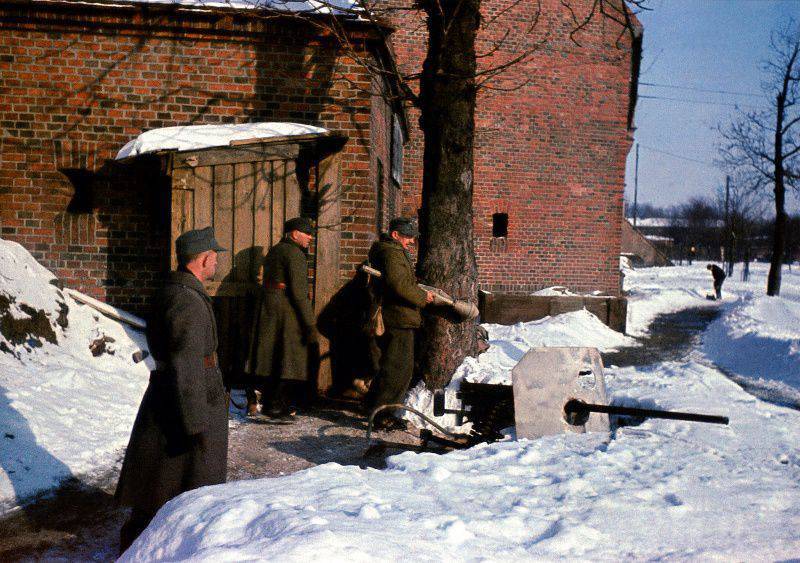
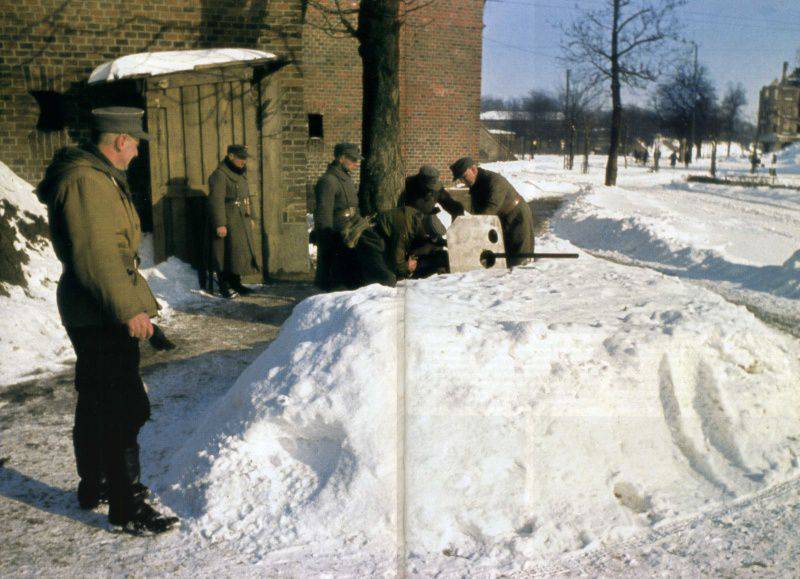
German soldiers in Koenigsberg near the MG 151 / 20 gun
German plans. Defense system
The German command was not going to capitulate and believed that the Königsberg garrison had sufficient forces for a long defense. In Berlin, they hoped that such a powerful fortress as Königsberg would allow the German bridgehead in East Prussia to be preserved and to pin down considerable Soviet forces that would not be able to act on Berlin and other directions. In addition, the preservation of the capital of East Prussia was a matter of prestige of the Third Reich. Hitler ordered to keep the city at all costs. From the SS was formed consolidated detachment, which was supposed to shoot the runners.
The command of the Zemland group discovered a regrouping of the Soviet troops. However, Muller did not expect a quick general offensive of the troops of the 3 of the Byelorussian Front. The commander of the 4 Army considered that he still had time to complete the formation of the 6-8 divisions. New connections planned to tighten the defensive orders of the first echelon and create tactical and operational reserves. In addition, they were going to complete the equipment of intermediate defense lines in 3-4 and 8-12 km from the front edge of the defense. At the same time, the German command planned a counter-offensive in order to expand freedom of maneuver in the area of Königsberg and seize the coast. In the future, they planned to launch a large-scale offensive in order to restore their positions in East Prussia.
However, the Soviet offensive destroyed these plans. The armies of the 3 of the Byelorussian Front completed the regrouping of forces and the preparation of a new offensive in a much shorter time than the Germans had assumed. In addition, the command of the Zemland group was mistaken with the direction of the main attack of the Red Army. Red Army. The Germans believed that the Soviet troops would strike at the Zemland direction and only then attack the completely blocked Koenigsberg. Therefore, the defense of the Landland Peninsula was strengthened by the Königsberg garrison. First, the 5 Tank Division was withdrawn from Königsberg, then, on the eve of the assault, only the replenished 1 Infantry Division. The 1 Infantry Division was located on the right flank of the 26 Army Corps.
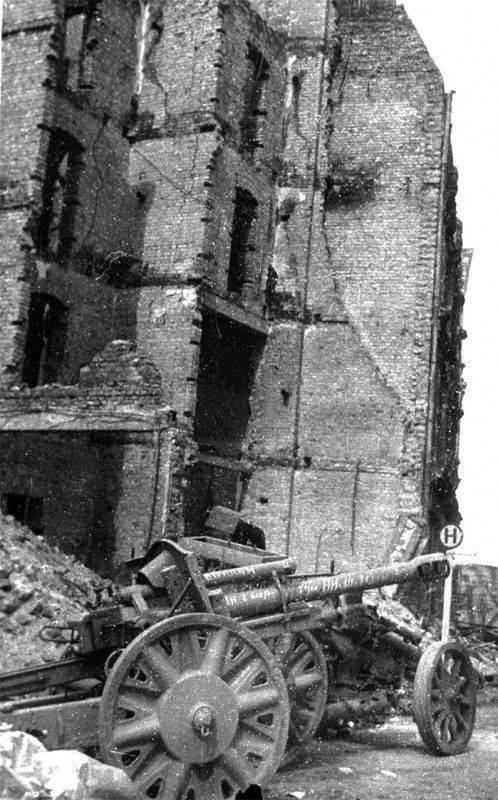
Abandoned German guns at the ruins of a building in Konigsberg after taking the city by storm
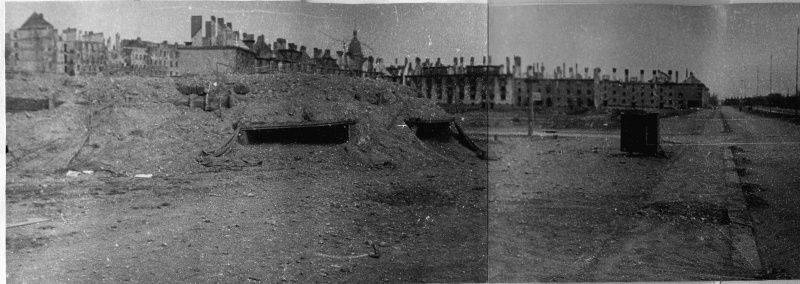
Königsberg, the German DZOT in the Horst Wessel Park area
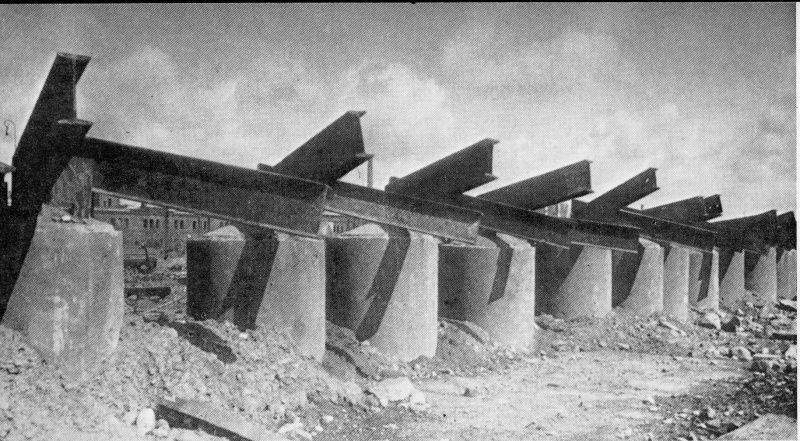
Königsberg, anti-tank barriers
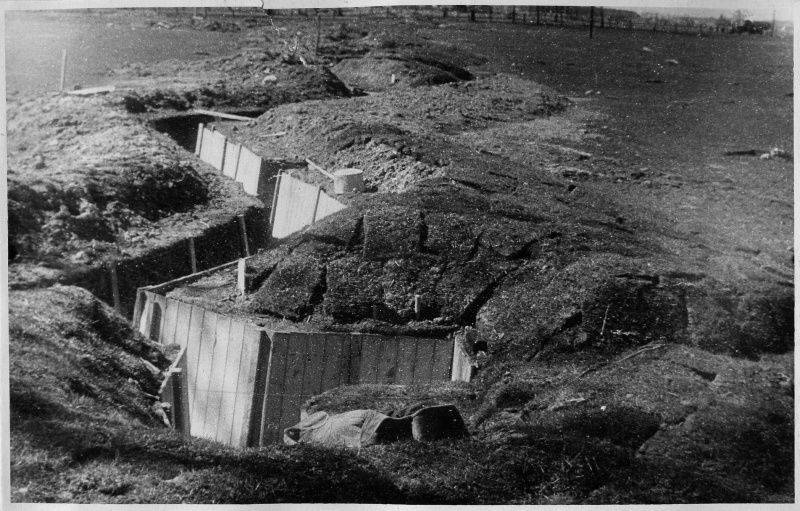
Königsberg, German trenches
The city, in fact, a large fortified area, was prepared for defense even in complete surroundings. The Red Army had not yet taken such a powerful fortress. Additional landing sites were equipped in the squares and streets of Königsberg. Before the start of the battle, the Germans opened the floodgates on the River Pregel and flooded the valley, which made it difficult for our troops to move. In the city there were underground military factories that provided a significant part of the needs of the enemy grouping, warehouses for supplies and materials were created. The city had a land connection with the Zemland group and the port of Pillau. This allowed them to maneuver forces, to transfer reinforcements, weapons, ammunition, fuel and all sorts of materials. All the necessary supplies were carried through the port of Pillau along the Königsberg Sea Canal to the port of Königsberg and along the unpaved and railways Pillau-Fishhausen-Koenigsberg. A cable was laid along the bottom of the Baltic Sea from the Zemland Peninsula to Central Germany, which made it possible to maintain a telegraph and telephone connection with Berlin.
The outer line of the fortifications of Königsberg was overcome by Soviet troops in January. In addition to him, the Germans equipped around the city three more defensive lines, which were saturated with long-term firing points, external and internal forts, shelters and anti-tank obstacles. These long-term fortifications supplemented the field structures. The first position with a length of 50 km was held in 6-8 kilometers from the city center and consisted of several trench lines (from 2-3 to 6-7), anti-tank racks, barbed wire and mine fields. The defensive position was covered by an anti-tank ditch 6-8 meters wide and 3 meters deep. In addition, the 15 defenses of the old fortress fortress, which had a fire connection, strengthened the defense. Each fort had a separate garrison for 250-300 soldiers. There were also up to 390 durable shelters.
The second defensive position was held on the outskirts of the city. Separate, strongest buildings were prepared for a long defense, had garrisons, they were surrounded by trenches. At the crossroads, they built long-term reinforced concrete weapon emplacements. The second position had 38 pillboxes, 25 bunkers and 214 shelters. The streets were barricaded, some sections were mined.
The third defensive position, about 10 km long, passed inside the city, along the old city line. It consisted of 9 old forts and buildings prepared for defense, palaces, castles (near 600 buildings), parks and even cemeteries that had many serious stone structures. Particularly well prepared for defense were the urban areas of Amalienau on the right bank of the Pregel River, in the offensive zone of the 43 Army, Beloborodov, Nasser Garten and Ponart - on the left bank, in the offensive zone of the Galitsky Guards Army. Many houses were mined to undermine when they were taken by Soviet soldiers. At the crossroads laid land mines. In the center of Königsberg stood an old citadel, adapted to a garrison of several thousand people.
The northwestern part of the city (in the 43 Army Band) was defended by the 561 and 548 I infantry divisions. According to our intelligence, the enemy here had up to 44 guns and mortars on the 1 km of front. Also, the German division gave about 40 tanks and SAU. The northern section was defended by the 367 Infantry Division, the eastern section was defended by the 61 Division headquarters, the southern section by the 69 Infantry Division, supported by three separate infantry regiments, fortress and militia battalions. On the coast of the Frisches-Huff Bay there was the Mikos battle group.
At the third position, a police combat group, one regiment of the 548 Infantry Division, eight battalions of the Volkssturm and several special units were in reserve. The fortress battalions were attached as reinforcements to the infantry divisions. Tank and anti-tank units of the garrison from assault divisions of infantry divisions (total 45 SAU), 502-th and 505-th tank battalions (28 machines) and 232-th brigade of assault guns (35 guns). All tanks and self-propelled guns were assigned to infantry units and installed in ambush positions for direct fire. In addition, the Königsberg garrison could reinforce the 5 Tank Division (85 tanks and 27 assault guns).
The garrison had a large artillery density. 33 artillery and mortar batteries were located in the north-western defense sector, 50 batteries were used for the northern and eastern sectors, and 23 artillery and 18 mortar batteries were in the southern sector. There were also 35 heavy mortars, 15 heavy throwers and 90 six barrels. The reserve command was two artillery regiments and one artillery division. As a result, the Germans had an artillery density of more than 40 guns and mortars on the 1 kilometer of the front. The air defense of the fortress was 18-I anti-aircraft division (3 regiment and 6 separate divisions). The division was armed with more than 300 anti-aircraft guns that could be used in anti-tank defense.
The morale of the Königsberg garrison was weakened. The loss of almost all of East Prussia, and especially the destruction of the Heilsberg grouping, undermined the morale of the troops. The soldiers understood that they were doomed and resistance was meaningless. In order to maintain the morale of the troops, the command used repressions, arranged various alarms, maintaining combat readiness, and also gave generous awards to those who distinguished themselves in battle. In general, the German garrison retained combat capability and was a serious opponent.
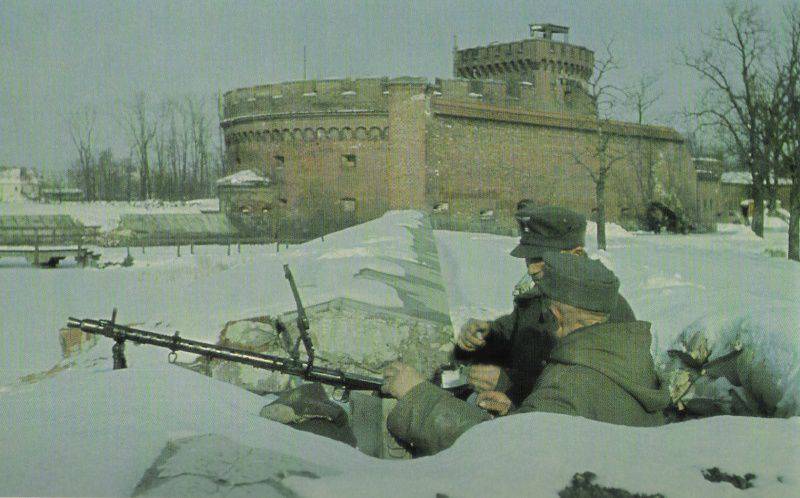
German machine-gun crew on the position of the fortress wall in front of a water moat. In the background, the tower "Dona"
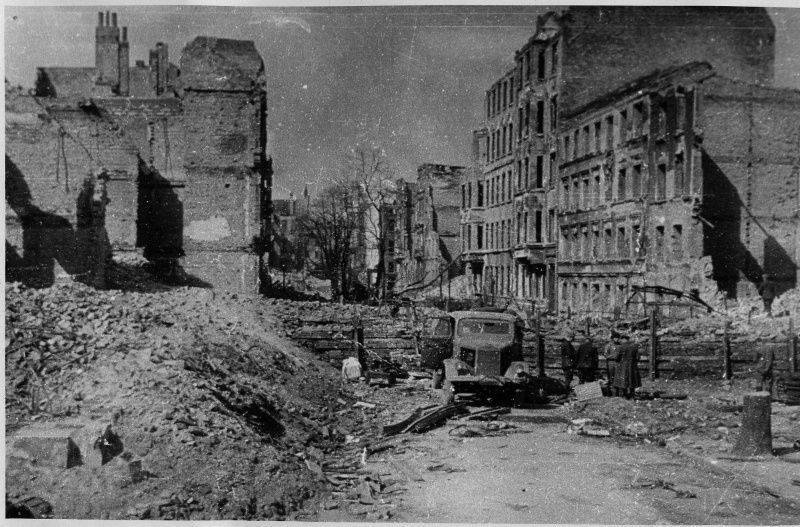
Königsberg, barricade on the street

Koenigsberg after the assault. German railroad viaduct prepared for demolition
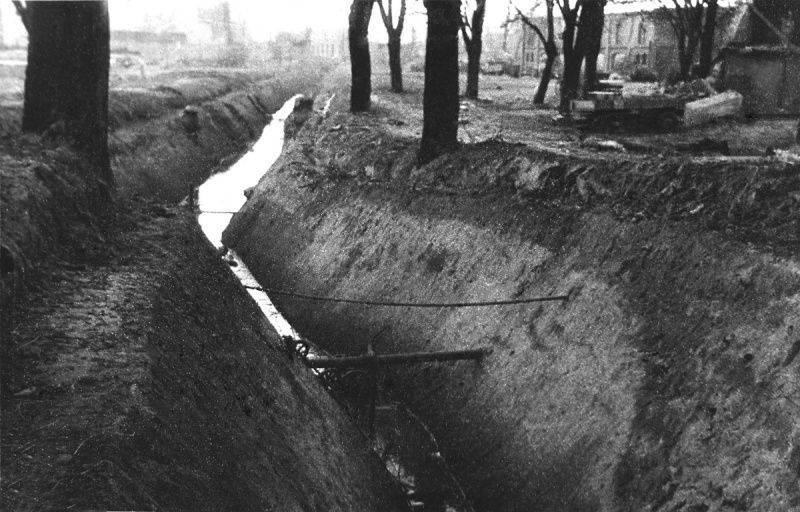
Anti-tank ditch in the area of the central market in Konigsberg
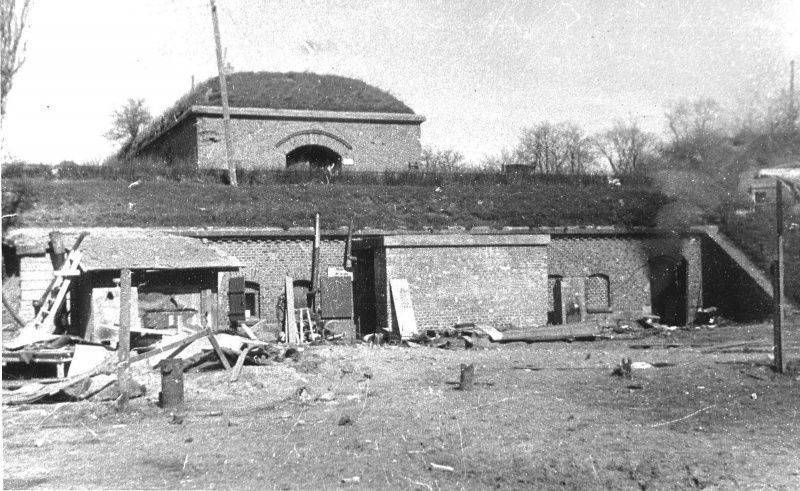
Staff shelter in the fortifications of the Grolman High Front of the Oberteich Bastion in Konigsberg after Surrender
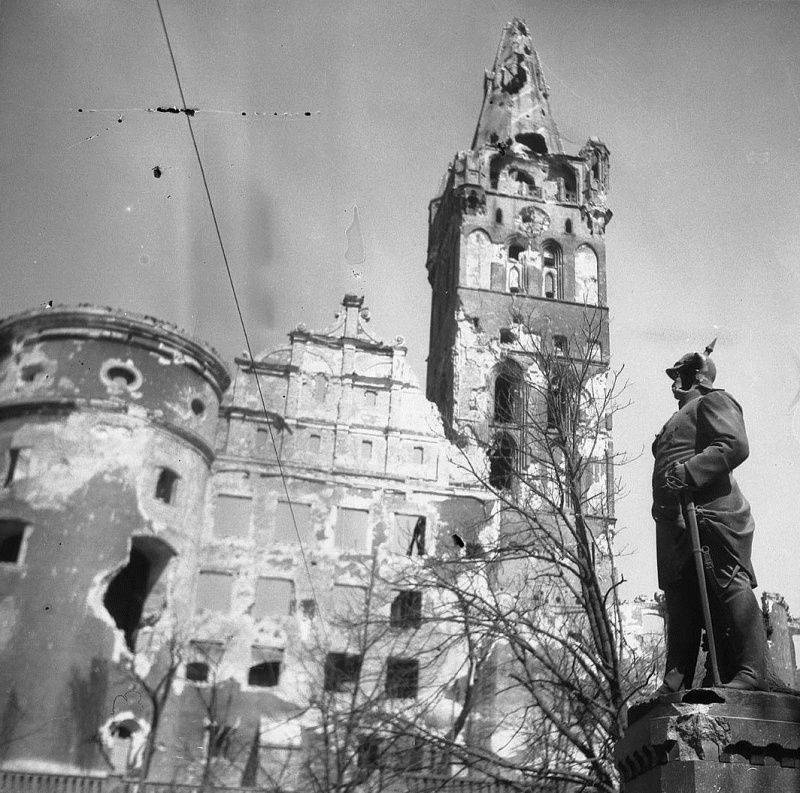
Destroyed during the fighting royal castle in Konigsberg
To be continued ...
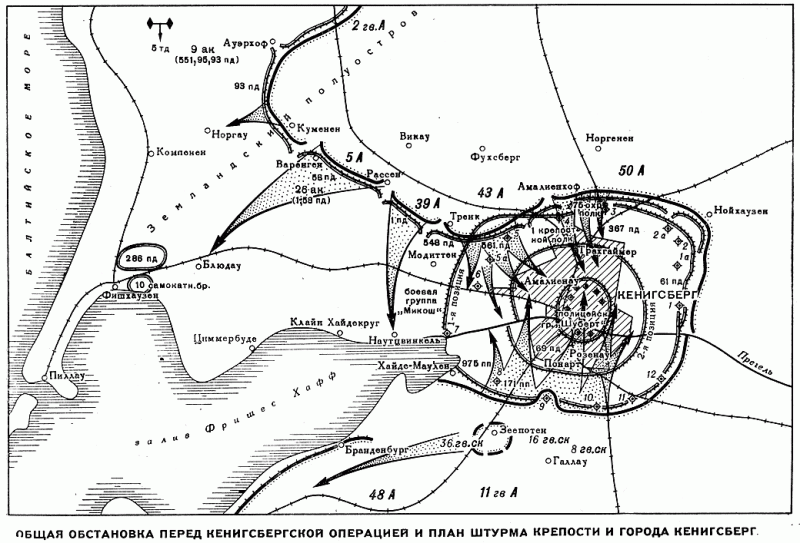
Information